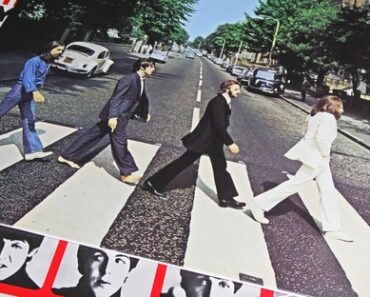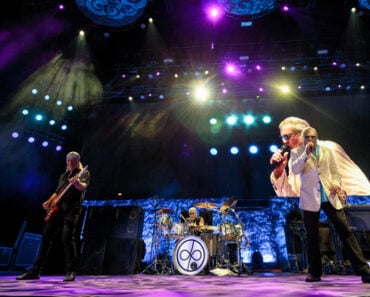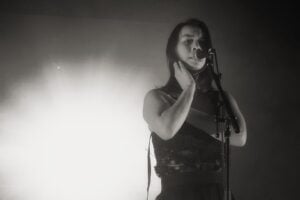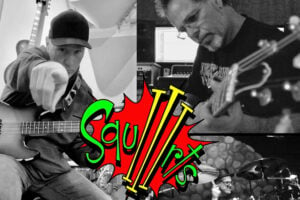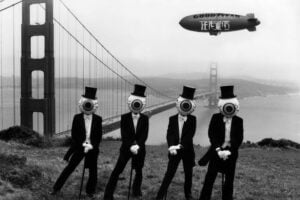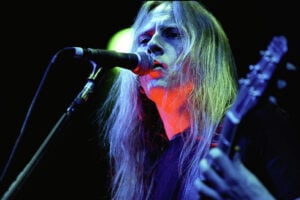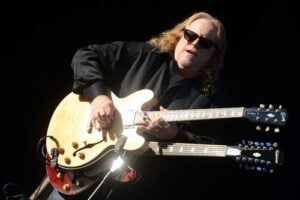
Feature Photo: Northfoto / Shutterstock.com
Our list of the top 10 most rocking Prince songs takes a deep dive into an artist who has been celebrated as one of the greatest musical talents of the past fifty years. While most discussions around Prince center on his groundbreaking catalog, which fused pop, soul, R&B, and rock into a sound that was entirely his own, one of the most common oversights is the lack of recognition for his extraordinary guitar work. It may have been in 2004, during his electrifying performance at the Rock and Roll Hall of Fame, where he delivered one of the most iconic guitar solos of all time, that Prince finally began receiving widespread acclaim for his talent as a guitarist. This article aims to showcase his guitar work that fueled many of his best rock-oriented tracks, highlighting the powerful, innovative playing that set him apart as a true rock legend.
# 10 – Computer Blue – Purple Rain
Opening the list of the “10 Most Rocking Prince Songs,” Computer Blue stands as an electrifying testament to Prince’s often-overlooked prowess as a rock guitarist. This track, featured as the fourth song on the iconic Purple Rain album released on June 25, 1984, is a sonic powerhouse that highlights the experimental and boundary-pushing elements of Prince’s artistry. The song, co-written by Prince with contributions from his father, John L. Nelson, captures the raw, emotive energy of rock, fusing it with Prince’s signature funk and new wave sensibilities. Recorded initially at The Warehouse in Minneapolis, Computer Blue was later refined at Sunset Sound in Los Angeles in August 1983, showcasing Prince’s meticulous attention to detail and collaborative spirit with The Revolution, particularly Wendy & Lisa and sound engineer Susan Rogers.
Prince’s intricate work on Computer Blue reflects a shift in his approach as he began blending live band recordings with sophisticated studio overdubs. The track’s foundation was built with The Revolution just a day after recording “Let’s Go Crazy,” signaling the explosive creativity during this period. The song evolved further in Los Angeles, where it transformed into the version featured on Purple Rain. Known for his perfectionism, Prince incorporated elements from “Father’s Song,” a piano instrumental written with his father, into the track’s haunting guitar solo. This familial collaboration highlights Prince’s deep-rooted connection to music as a legacy and personal expression.
What makes Computer Blue stand out as a rock anthem is its relentless, distorted guitar riff that cuts through layers of heavy synths and programmed drum patterns, creating a fusion that feels simultaneously futuristic and primal. The song begins with a spoken-word introduction by Wendy & Lisa, invoking a dominatrix dynamic that sets a provocative tone. The interplay of sensuality and aggression continues throughout the song as it unfolds into an experimental rock piece, with Prince’s guitar work taking center stage. The extended versions of the track, particularly the “Hallway Speech” version, run over twelve minutes and offer an even more intense exploration of Prince’s rock capabilities, demonstrating his confidence in blending extended improvisation with structured composition.
Lyrically, Computer Blue delves into the complexities of human emotions, love, and technology—a recurring theme that Prince often explored. The lyrics depict a search for connection amidst digital disarray, as Prince’s character laments the malfunctioning “machinery” of his love life. Lines such as “Where is my love life? Where can it be?” and “Somebody please, please tell me what the hell is wrong” convey a sense of disillusionment and frustration, mirroring the angst-filled guitar riffs that accompany them. This merging of lyrical and musical tension exemplifies how Prince uses rock’s raw energy to embody emotional turmoil, particularly through the song’s climax, where he shreds on the guitar with an intensity that reflects the breakdown he sings about.
The song’s portrayal of a “lonely computer” searching for love but failing to understand human emotions taps into the 1980s fascination with technology while simultaneously critiquing the alienation that can accompany it. The metaphor of the computer being unable to “learn love and lust” suggests a deeper commentary on modern relationships, highlighting Prince’s knack for blending social commentary with musical innovation.
Despite being an album track rather than a single, Computer Blue is a critical element of the Purple Rain album’s narrative and musical arc. It provides a bridge between the more structured pop songs on the album and the explosive, genre-blurring jams Prince was known for in his live performances. Critics have noted the track’s role in pushing the boundaries of rock within the context of 1980s music, showing that Prince could hold his own as a guitarist against rock’s heavyweights. The song’s guitar-driven aggression and complex layering also reveal why Prince was not just a pop or funk artist but a multi-dimensional musician capable of mastering the art of rock.
Prince’s Computer Blue serves as a thrilling opener for this list of his most rocking songs. It sets the tone for the rest of the article, showcasing how his guitar work, often overshadowed by his vocal and songwriting talents, was an essential component of his musical identity. As the first song on the list, it invites readers to dive into Prince’s rock repertoire with an appreciation for his unparalleled guitar skills and his ability to weave complex emotions and social themes into electrifying rock performances.
# 9 – Electric Chair – Batman
“Electric Chair” is a standout track from Batman, Prince’s 1989 soundtrack album for Tim Burton’s film. This song, like much of the album, showcases Prince’s dynamic guitar skills and his rock-oriented side, a facet often overshadowed by his vocal and songwriting prowess. It’s fitting that “Electric Chair” is the opening song on this new list of Prince’s most rocking tracks, as it highlights the artist’s underrated guitar abilities and serves as a powerful introduction to the more rock-centered side of his catalog.
Recorded in the summer of 1989 at Prince’s Paisley Park Studios, “Electric Chair” was initially laid down during the sessions for Batman alongside other tracks like “Scandalous!” and “Vicki Waiting.” The album, recorded primarily by Prince himself, was produced entirely by him, and features his multi-instrumental talents on guitar, bass, drums, and synths. The project was completed in just six weeks, demonstrating Prince’s ability to deliver a high-energy album with cohesive storytelling in a short time. This song, specifically attributed to the Joker’s perspective within the album’s concept, captures the chaotic and rebellious energy associated with the character.
Musically, “Electric Chair” is an explosive rock track filled with heavy guitar riffs, a powerful rhythm section, and a gritty vocal performance from Prince. The song opens with an intense, distorted guitar line that sets the tone for the rest of the track, making it one of the most rock-driven songs on Batman. Prince’s mastery of the electric guitar is front and center, with blistering solos that amplify the track’s urgency and theatrical flair. His guitar playing here is full of energy and precision, illustrating his deep understanding of rock music’s raw intensity, and yet it remains infused with his signature funk and R&B grooves.
Lyrically, “Electric Chair” explores themes of desire and guilt, fitting the dark and moody atmosphere of the Batman universe. Prince’s lyrics, such as “If a man is considered guilty for what goes on in his mind / Then give me the electric chair for all my future crimes,” reflect the inner turmoil and reckless abandon of the Joker’s character. The song intertwines sensuality with themes of punishment, adding layers to its narrative. The line “The music rocked us, our eyes locked” plays into the seductive energy Prince often injected into his music, turning the song into a fusion of rock, desire, and dark theatrics. This lyric-driven approach enhances the song’s impact, blending Prince’s storytelling with his characteristically provocative and enigmatic style.
“Electric Chair” is not just a testament to Prince’s guitar skills; it’s also a reminder of how he could seamlessly blend different genres to create a sound uniquely his own. As the first track on this list of Prince’s most rocking songs, it sets the bar for the guitar-heavy, energetic performances that follow.
# 8 – Guitar – Planet Earth
“Guitar” is a rock-infused gem from Prince’s Planet Earth, a 2007 album that showcases his often underappreciated prowess as a guitar virtuoso. Featured prominently in his live performances and promotional material, the song is a celebration of his undeniable skill on the instrument, and it serves as a testament to the rock energy Prince could summon when he plugged in his guitar. This track is included in the Anthology: 1995-2010, highlighting Prince’s evolution as an artist during a period when he explored and perfected different musical styles. “Guitar” not only stands out for its infectious rhythm and electric soloing but also because it underscores Prince’s love for the guitar—a love so strong that it becomes the very subject of the song.
The song was first previewed on Prince’s official website, 3121.com, around the time of his iconic Super Bowl Halftime Show performance in February 2007. Recorded at Paisley Park Studios, Guitar was produced solely by Prince, who also played all the instruments on the track, further demonstrating his multi-instrumental talent. This song reflects the tight production style he was known for during this era, combining sharp guitar riffs, funky basslines, and precise drumming. Prince’s performance is backed by his band at the time, which included drummer Cora Coleman-Dunham, bassist Josh Dunham, and keyboardist Morris Hayes. Together, they create a polished yet energetic atmosphere, with Prince’s guitar taking the spotlight.
Musically, “Guitar” delivers the hard-hitting rock sound Prince was capable of but often kept on the backburner in favor of his funk and pop hits. The track opens with a riff that instantly grabs attention and sets the tone for what becomes a blistering display of guitar work. Throughout the song, Prince’s guitar leads carry the melody, delivering searing solos and intricate licks that demonstrate his technical prowess and expressive playing style. The video for “Guitar,” which was filmed to accompany the album’s release, features Prince and his band performing with infectious energy, showing his comfort and command in a live setting. The Twinz, Maya and Nandy McClean, add a dynamic visual element, enhancing the song’s high-energy vibe.
Lyrically, “Guitar” plays with the metaphor of love and devotion, comparing Prince’s affection for a lover to his unbreakable bond with his guitar. Lines like “I love you baby, but not like I love my guitar” humorously emphasize this point, showing how nothing comes close to his passion for music. It’s a playful yet earnest take on prioritizing one’s art, with Prince’s delivery giving the impression that his guitar holds a more permanent place in his life than any fleeting romance could. The lyrics highlight his tongue-in-cheek style, as he skillfully navigates the fine line between sincerity and humor.
As the song builds, the intensity of Prince’s guitar solos amplifies, perfectly aligning with the song’s theme and reaffirming why this track is a perfect addition to the list of Prince’s most rocking songs. In an era when Prince was exploring a variety of genres, “Guitar” stands out as a straightforward declaration of his rock credentials, putting his guitar work front and center and allowing listeners to experience the raw energy and musical genius that he was capable of delivering on any stage.
# 7 – The Cross – Sign O’ The Times
“The Cross” is one of Prince’s most powerful and rock-driven tracks from his acclaimed 1987 album Sign o’ the Times. Known for its spiritual and emotional depth, the song highlights Prince’s often-overlooked prowess as a guitarist. The album was released on March 30, 1987, and marked Prince’s first solo endeavor after disbanding The Revolution. The recording sessions for Sign o’ the Times spanned 1986 to 1987 at Prince’s iconic Paisley Park Studios, showcasing his remarkable versatility as a songwriter and multi-instrumentalist. As a project that evolved from several scrapped albums, including Dream Factory and Crystal Ball, Sign o’ the Times ultimately emerged as a double album—one that would solidify Prince’s legacy in rock, funk, and pop.
Musically, “The Cross” stands out as a testament to Prince’s ability to fuse his electric guitar skills with intense, spiritual lyricism. The track begins with a stripped-down acoustic guitar riff before building into a full-blown electric rock anthem, featuring searing guitar solos and heavy drumbeats that emphasize its spiritual message. Prince’s approach to “The Cross” is reminiscent of classic rock ballads, where the gradual build-up culminates in an electrifying display of guitar mastery. This dynamic progression showcases his capacity to channel raw emotion through his instrument, creating an atmosphere that’s both contemplative and explosive. The combination of rock and gospel elements reinforces the song’s spiritual theme, with Prince’s guitar serving as the emotional heartbeat of the track.
Lyrically, “The Cross” is a call for salvation and resilience in the face of hardship, offering hope amidst despair. Prince sings of “black days” and “stormy nights” as he paints a bleak picture of suffering, while also pointing to salvation through faith. The imagery of “ghettos to the left of us, flowers to the right” suggests a world divided between suffering and beauty, yet Prince emphasizes that all problems, regardless of their scale, can be resolved through faith. His vocal delivery becomes increasingly urgent as the song progresses, mirroring the intensity of his guitar work, which crescendos in tandem with his plea for unity and hope. The intertwining of these elements gives “The Cross” a haunting, almost transcendental quality that distinguishes it from other tracks on Sign o’ the Times.
From a critical perspective, “The Cross” is often lauded for its raw and authentic sound. It stands as one of the most spiritually and emotionally charged tracks in Prince’s catalog, highlighting his ability to cross genres and deliver a message through powerful instrumentation. While Prince’s vocals and songwriting often steal the spotlight, his guitar playing on “The Cross” showcases a level of intensity and proficiency that rivals any rock guitar legend. The song is not just a rock anthem; it’s a testament to Prince’s deep, spiritual artistry and his unparalleled skill as a guitarist.
# 6 – Endorphinmachine – The Gold Experience
“Endorphinmachine,” from The Gold Experience, is one of Prince’s most electrifying rock tracks, emphasizing his unparalleled talent as a guitarist. Released on September 26, 1995, under his unpronounceable “Love Symbol” moniker, this song showcases Prince’s ability to channel raw rock energy. Known for its fierce guitar riffs and high-octane energy, “Endorphinmachine” is a testament to Prince’s skill as a rock musician, making it a fitting entry on this list dedicated to Prince’s most rocking tracks. The song was recorded in 1993 at Paisley Park Studios, a place where Prince continually pushed musical boundaries. The Gold Experience marked a pivotal moment for Prince, blending rock, funk, and soul while highlighting his virtuosity and lyrical storytelling.
From its opening moments, “Endorphinmachine” roars with distorted guitar riffs and relentless drumming. The track grabs listeners with its aggressive, pulsating energy—showing Prince’s mastery of the electric guitar. His solos are precise yet full of emotional intensity, driving the song forward with an infectious force. The song features Tommy Barbarella on keyboards, bringing a futuristic, metallic edge that complements the raw power of Prince’s guitar. The chemistry among the musicians gives the track its distinctive rock flavor, and Prince’s explosive soloing highlights why he is so often cited as an underrated guitarist. Much like “Computer Blue” from Purple Rain, “Endorphinmachine” combines heavy guitar elements with a sense of urgency, though here Prince moves into a harder, grittier sound that reflects his mid-90s evolution.
Lyrically, “Endorphinmachine” is full of rebellious energy, with Prince issuing a playful but intense call to action. The song’s lyrics explore themes of liberation and adrenaline, aligning perfectly with its sonic intensity. Prince invites listeners on a ride through this “endorphin” experience, likening it to a thrill-seeking adventure. The phrase “Press one for the money, press two for the dream” captures the track’s exhilarating, almost surreal atmosphere, where Prince challenges the listener to embrace the power of transformation. The song’s urgency is further heightened by his rapid-fire delivery, which mimics the rhythm of the guitar riffs, creating a sense of propulsion throughout.
Critically, “Endorphinmachine” stands out as a prime example of Prince’s mid-90s experimentation. Despite The Gold Experience achieving notable chart success, with the album reaching number six on the Billboard 200 and number two on the Top R&B Albums chart, “Endorphinmachine” itself was never released as a single. Nevertheless, it became a fan favorite for its unapologetic rock edge and fiery performances during Prince’s live shows. The song’s aggressive style and hard-rock elements are a reminder of Prince’s versatility, as he seamlessly moved from funk grooves to the searing guitar work that characterizes “Endorphinmachine.”
# 5 – Temptation – Around The World In A Day
“Temptation” from Around the World in a Day is one of Prince’s most electrifying and guitar-driven tracks, and it showcases his ability to fuse rock with his signature blend of funk and psychedelic influences. Released on April 22, 1985, this track embodies Prince’s experimental spirit, as he veers away from the commercial appeal of Purple Rain to explore more adventurous sonic landscapes. The song was recorded at Sunset Sound in Los Angeles and produced entirely by Prince, who also performed most of the instruments. With its scorching guitar solos and theatrical flair, “Temptation” reveals the raw rock energy that fuels Prince’s creativity, making it a vital inclusion on this list dedicated to his most rocking songs.
The track begins with a sultry and provocative delivery, establishing a mood that is both sensual and intense. Prince’s guitar work in “Temptation” is searing, and his riffs cut through the track with precision, demonstrating his underrated prowess as a guitarist. While his vocal range is dynamic and emotive, it’s the fierce guitar solos that truly drive the song’s energy. Prince’s guitar cries out in response to the raw, carnal themes of the song, echoing the tension and passion he sings about. This track, like “Endorphinmachine” from The Gold Experience, showcases Prince’s ability to inject powerful rock elements into his music, creating an electric atmosphere that is both hypnotic and intense.
Lyrically, “Temptation” explores themes of desire, lust, and the moral struggle that accompanies them. Prince describes his longing in vivid, poetic imagery, using lines like “Working my body with a hot flash of animal lust” to convey the primal nature of his temptations. As the song progresses, the lyrics take a theatrical turn, with Prince engaging in a dialogue that highlights a battle between his sensual desires and his conscience. This spoken-word breakdown builds to a climactic moment where Prince confronts the consequences of succumbing to temptation. The dramatic ending, with Prince’s character pleading for redemption, adds a layer of depth to the song, moving it beyond just another rock anthem.
Critically, “Temptation” stands as one of Prince’s boldest rock statements. Although Around the World in a Day received mixed reviews compared to Purple Rain, this track shows Prince’s fearless willingness to experiment and blend genres. Its unapologetic energy, combined with the theatrical elements and electrifying guitar work, make “Temptation” a standout on the album. The song’s intensity and exploration of desire align it with other rock-driven tracks on this list, demonstrating how Prince’s guitar playing can transform a song into a powerful, immersive experience
Read More: 10 Best Covers Of Prince Songs
# 4 – Chaos and Disorder – Chaos and Disorder
“Chaos and Disorder” from the album Chaos and Disorder is a powerful rock anthem that highlights Prince’s prowess as a guitarist, putting his often-underappreciated rock edge on full display. Released on July 9, 1996, during Prince’s tumultuous period with Warner Bros. Records, this track was part of an album meant to fulfill contractual obligations, yet it stands out as a testament to his musical brilliance even in challenging circumstances. The album was recorded quickly, with Prince himself stating that it was created with the intent to thrash out material as fast and hard as possible. The song’s energy reflects this raw, unfiltered approach, blending rock, funk, and a gritty grunge aesthetic. Despite the album’s relatively low chart position in the United States, peaking at number 26, “Chaos and Disorder” is a high-octane rocker that deserves a place among Prince’s most dynamic and electrifying tracks.
The song’s recording sessions featured members of Prince’s backing band, the New Power Generation, including the return of Rosie Gaines on vocals and the powerful rhythm section of Michael B. on drums and Sonny T. on bass. These musicians infused the track with a relentless energy, while Prince’s blistering guitar solos take center stage. The song’s explosive riffs and aggressive style showcase his mastery of the guitar, making it a prime example of why he was one of the greatest rock guitarists of his time. The track is a departure from the more polished sounds of his earlier albums, opting instead for a rougher, edgier sound that aligns it with other hard-hitting songs like “Endorphinmachine.”
Lyrically, “Chaos and Disorder” is a scathing commentary on societal decay, filled with Prince’s signature wit and bite. He tackles the chaos of the modern world through vivid imagery and biting observations. Lines like “I’m just a no-name reporter, I wish I had nothing to say” reflect his frustration with the relentless negativity in media and society. The song’s rebellious spirit, combined with its furious guitar work, channels a similar energy to tracks like “Electric Chair,” showing Prince’s ability to combine his lyrical critique with musical intensity. The fast tempo, heavy distortion, and grungy atmosphere of the track reinforce the sense of chaos that permeates both the lyrics and the overall soundscape.
Read More: Top 25 Prince Songs
# 3 – Bambi – Prince
“Bambi,” one of the standout tracks from Prince’s self-titled second studio album Prince, released on October 19, 1979, is a powerful demonstration of Prince’s rock sensibilities and guitar prowess. While much of the album blends R&B, funk, and pop, “Bambi” veers into hard rock territory, showcasing his versatility and his ability to transcend genre boundaries. Written, arranged, composed, and performed entirely by Prince, the song is an early indicator of the guitar hero he would become, featuring scorching riffs and electrifying solos. The track not only highlights Prince’s guitar skills but also his flair for combining provocative lyrics with energetic rock instrumentation.
Recorded at Alpha Studios in Burbank, California, “Bambi” is a raw and unfiltered rock anthem with an edge reminiscent of 1970s hard rock bands, but with a uniquely Prince twist. The production is minimalist, allowing the guitar to take center stage and dominate the soundscape. Prince’s guitar playing is aggressive, filled with distortion and piercing solos that contrast sharply with his soulful and emotive vocal delivery. The song reflects Prince’s ability to harness his technical skill on the guitar and infuse it with emotional intensity, an approach he would continue to refine throughout his career. This style makes “Bambi” stand out as one of his most rocking tracks from the early years, and it’s a precursor to later high-energy songs like “Electric Chair.”
Lyrically, “Bambi” is a bold and provocative narrative that addresses unrequited love and sexual frustration. Prince sings about his attraction to a woman who prefers other women, and he attempts to convince her to choose him instead, proclaiming, “Bambi, can’t you understand? Bambi, it’s better with a man.” The lyrics are daring, even controversial for the time, and they highlight Prince’s willingness to push boundaries and challenge norms—both musically and socially. His vocal performance, combined with the blistering guitar solos, amplifies the urgency and passion behind the lyrics, creating a powerful rock statement that grabs the listener’s attention. The song’s raw energy and unrestrained emotion set it apart, making it an essential track for showcasing Prince’s rock credentials.
Critically, “Bambi” is often noted as one of Prince’s earliest forays into the rock genre, foreshadowing the guitar-heavy sound he would explore further in later albums. The song’s heavy guitar work and provocative lyrics distinguished it from the rest of the Prince album, which primarily featured more funk and R&B-oriented tracks like “I Wanna Be Your Lover.” As such, “Bambi” remains a crucial entry in his catalog for those who appreciate the rock side of Prince’s musical identity. It stands as an early testament to his guitar talent, a facet that, while sometimes overshadowed by his vocals and songwriting, would come to be celebrated by those who understood his full range as a musician. This track, with its unapologetically raw rock edge, is an essential part of Prince’s evolution as a rock artist and solidifies his place in the pantheon of guitar greats.
Read More: Top 10 Prince And The Revolution Songs
# 2 – Let’s Go Crazy – Purple Rain
“Let’s Go Crazy,” the electrifying opening track from Prince and The Revolution’s 1984 album Purple Rain, is one of the most iconic rock anthems in Prince’s discography. Released as a single, it quickly became his second number-one hit on the Billboard Hot 100, also topping the Hot R&B/Hip-Hop Songs and Hot Dance Club Play charts. As the first track on the album and in the film Purple Rain, the song sets the stage with a sermon-like intro that builds into an explosive blend of rock and funk, showcasing Prince’s virtuosity on the guitar and his ability to fuse genres seamlessly. “Let’s Go Crazy” is more than just a song; it’s a manifesto, urging listeners to embrace life with an intensity that echoes the energy and unpredictability of Prince’s guitar work.
Recorded at The Warehouse in Minneapolis in 1983, “Let’s Go Crazy” features Prince’s signature multi-instrumental talents, with contributions from his band, The Revolution. The track’s high-octane guitar riffs, backed by Wendy Melvoin’s rhythm guitar, Lisa Coleman’s keyboards, Brown Mark’s bass, Bobby Z’s drums, and Dr. Fink’s synthesizers, create a sonic landscape that is both exhilarating and defiant. Prince’s production on the track highlights his mastery over instrumentation and arrangement, as he meticulously crafted each layer to build momentum, leading to the climactic guitar solo. This solo, which showcases his technical skill and emotional intensity, solidifies the song’s place as a rock classic. The song’s extended “Special Dance Mix,” used in the film, includes an instrumental section that pushes the boundaries of conventional pop-rock, with a chugging guitar riff and a distorted, atonal piano solo that add an experimental flair.
Lyrically, “Let’s Go Crazy” is an invitation to break free from life’s struggles and to resist conformity, symbolized by the “elevator” that tries to bring you down—a metaphor Prince used for the Devil. The lyrics, filled with a sense of urgency and rebellion, implore the listener to live life fully before it’s too late: “You better live now before the Grim Reaper comes knocking on your door.” The song’s message is both spiritual and existential, blending religious imagery with an anarchic spirit. Prince’s exhortation to “punch a higher floor” becomes a rallying cry for transcendence and self-liberation, themes that resonate throughout his work.
Critically, “Let’s Go Crazy” is celebrated not only for its chart success but also for its impact as a live performance staple. Prince’s fiery guitar solo in the song remains a defining moment of his career, reminding audiences of his underrated status as a guitarist. While tracks like “Bambi” also emphasize his guitar prowess, “Let’s Go Crazy” amplifies it with an arena-rock energy that blends the intensity of 1980s hard rock with Prince’s signature funk flair. It’s a perfect representation of how Prince could transcend musical genres, infusing his songs with a sense of unpredictability and spontaneity. As one of the most rocking songs in his catalog, “Let’s Go Crazy” is a definitive statement of Prince’s electric stage presence and unparalleled skill as a guitarist and performer.
Read More: Top 10 Prince Album Covers
# 1 – Dreamer – LOtUSFLOW3R
“Dreamer,” a standout track from Prince’s LOtUSFLOW3R album, released on March 24, 2009, is a searing rock number that highlights Prince’s exceptional guitar prowess. The album itself, a triple-disc set including MPLSound and Bria Valente’s Elixer, marked Prince’s thirty-third and thirty-fourth studio efforts. It debuted at number two on the US Billboard 200, proving that even decades into his career, Prince continued to captivate audiences with his multi-faceted talent. “Dreamer,” recorded at Paisley Park Studios, serves as a powerful reminder of Prince’s ability to blend politically charged lyrics with intense, guitar-driven rock, making it an essential addition to any discussion about his most rocking songs.
In “Dreamer,” Prince channels the spirit of 1960s and 1970s rock with blistering guitar solos reminiscent of Jimi Hendrix, whom Prince openly admired. The track’s raw energy and unfiltered aggression are fueled by his guitar work, which is both technically impressive and emotionally resonant. Prince’s riff-heavy performance and powerful soloing carry the song’s weight, pushing it beyond a typical rock number into an expression of social and political frustration. This track is a bold statement, proving that Prince was not only an extraordinary songwriter and vocalist but also one of the most formidable guitarists of his generation—a fact that often gets overshadowed by his other talents.
Lyrically, “Dreamer” dives deep into themes of systemic racism and social inequality. Prince draws on his own experiences and historical events, such as the assassination of Dr. Martin Luther King Jr., to critique the state of American society. Lines like “I was born, raised on a slave plantation / In the United States, of the red, white and blue” set a provocative tone, while his vocal delivery amplifies the intensity of the song’s message. He explores the idea of being labeled a “dreamer” for wanting societal change, weaving a narrative that feels both deeply personal and universally relevant. The song’s heavy, distorted guitar riffs serve as a fitting backdrop to these intense themes, giving the track a gritty and rebellious edge that sets it apart as one of the most politically charged and musically aggressive songs in Prince’s catalog.
Compared to other songs on this list, “Dreamer” stands out for its directness and unapologetic energy. While tracks like “Let’s Go Crazy” channel a more celebratory and energetic rock vibe, “Dreamer” is fierce, rooted in social commentary, and reminiscent of protest songs from rock’s earlier eras. The song’s urgency and Prince’s electrifying guitar performance elevate it to one of the most compelling entries in his later work, emphasizing the rock edge that Prince could masterfully harness when needed. This track is a testament to his versatility and his ability to use the guitar as a tool for both musical and social expression, affirming his status as one of the most underrated guitarists in rock history.
Read More: Complete List Of Prince Albums And Discography
We could not compose a list of the most rocking Prince songs without including a tribute to one of his most magical moments when he played the guitar solo to “While My Guitar Gently Weeps” at the Rock and Roll Hall of Fame ceremony in 2004.









![LotusFlow3r by Prince, Bria Valente [Music CD]](http://m.media-amazon.com/images/I/51nRI-ohr+L._SL500_.jpg)




